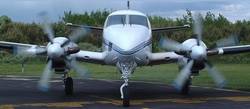Mon, Mar 31, 2003

A proposal to simplify and clarify the way aircraft operations
are classified in Australia has been published by the Civil
Aviation Safety Authority. The Classification of Operations
proposal features three classes of aircraft operations – air
transport, aerial work and general aviation.
The new classifications are put forward in a notice of proposed
rule making issued by CASA this month. Comments on the proposal
close on 12 May 2003.
 Everyone involved in Australian aviation is being
urged to study the new classification of operations policy as it
proposes a different way of classifying how aircraft are used in
the future. Key changes are the abolition of the charter category,
the listing of aerial work activities and the classification of all
operations that are not air transport or aerial work as general
aviation.
Everyone involved in Australian aviation is being
urged to study the new classification of operations policy as it
proposes a different way of classifying how aircraft are used in
the future. Key changes are the abolition of the charter category,
the listing of aerial work activities and the classification of all
operations that are not air transport or aerial work as general
aviation.
CASA’s executive manager Standards, Bill McIntyre, says
the proposals clear up a lot of the uncertainties in the current
classification of operations. “At the moment the definition
of aerial work is unclear and subject to interpretation,” Mr
McIntyre says.
“Under the proposed new rules aerial work operations would
be clearly set out and formally listed. If a flying activity is not
on the aerial work list, then it would not be classified as aerial
work.
“CASA is also proposing to ease the regulatory burden on
aerial work operators by replacing many air operators certificates
with a less onerous and more relevant operating
certificate.”
 The new air transport category would include all
fare-paying passenger-carrying operations, abolishing the separate
classifications for regular public transport and charter flights.
For some charter flights this would mean a lift in some safety
standards – although small operators will naturally not be
expected to meet the same standards as large air transport
carriers.
The new air transport category would include all
fare-paying passenger-carrying operations, abolishing the separate
classifications for regular public transport and charter flights.
For some charter flights this would mean a lift in some safety
standards – although small operators will naturally not be
expected to meet the same standards as large air transport
carriers.
“CASA believes fare paying passengers have the right to
appropriate safety standards, whether the flight is a scheduled
airline service or not. This means some smaller charter operators
would be required to meet higher standards,” Mr McIntyre
says.
More News
Airplane Bounced About 3 Ft Then Touched Back Down And Then, With No Brakes Applied, The Airplane Began Veering To The Left Analysis: The pilot entered the airport traffic pattern >[...]
Aero Linx: British Microlight Aircraft Association (BMAA) The primary focus within all aviation activity is SAFETY. In all aspects of our sport SAFETY must come first, whether it b>[...]
From SnF25 (YouTube Edition): William Wynne Builds Practical Aircraft Engines on the Corvair Platform Seeking an affordable alternative to the traditional aircraft engine options, >[...]
How To Get A Story On Aero-TV News/Feature Programming How do I submit a story idea or lead to Aero-TV? If you would like to submit a story idea or lead, please contact Jim Campbel>[...]
From 2023 (YouTube Edition): Bridge of CiES CiES Inc. is a Bend, Oregon-based designer and manufacturer of modular embedded aircraft systems and sensors. The company’s fuel-l>[...]
 NTSB Final Report: Aviat A1
NTSB Final Report: Aviat A1 ANN's Daily Aero-Linx (07.08.25)
ANN's Daily Aero-Linx (07.08.25) Classic Aero-TV: Fly Corvairs Reliable Engine Alternative
Classic Aero-TV: Fly Corvairs Reliable Engine Alternative ANN FAQ: Contributing To Aero-TV
ANN FAQ: Contributing To Aero-TV Classic Aero-TV: CiES Fuel-Quantity and e-Throttle Systems Praised
Classic Aero-TV: CiES Fuel-Quantity and e-Throttle Systems Praised





